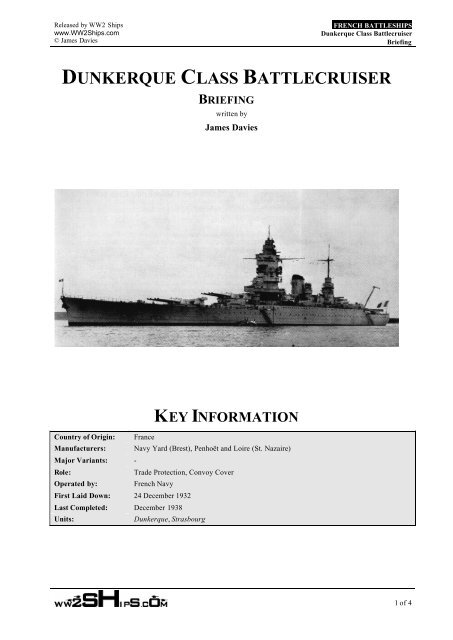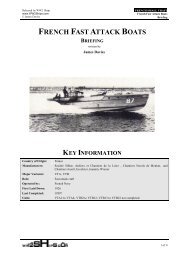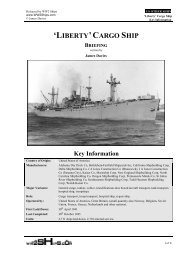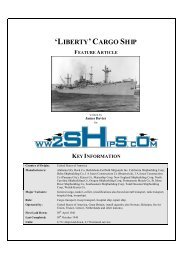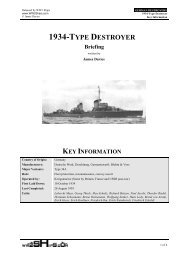Dunkerque Class Short - 040510 - World War Two Ships
Dunkerque Class Short - 040510 - World War Two Ships
Dunkerque Class Short - 040510 - World War Two Ships
You also want an ePaper? Increase the reach of your titles
YUMPU automatically turns print PDFs into web optimized ePapers that Google loves.
Released by WW2 <strong>Ships</strong><br />
www.WW2<strong>Ships</strong>.com<br />
© James Davies<br />
FRENCH BATTLESHIPS<br />
<strong>Dunkerque</strong> <strong>Class</strong> Battlecruiser<br />
Briefing<br />
DUNKERQUE CLASS BATTLECRUISER<br />
BRIEFING<br />
written by<br />
James Davies<br />
KEY INFORMATION<br />
Country of Origin: France<br />
Manufacturers: Navy Yard (Brest), Penhoët and Loire (St. Nazaire)<br />
Major Variants: -<br />
Role:<br />
Trade Protection, Convoy Cover<br />
Operated by: French Navy<br />
First Laid Down: 24 December 1932<br />
Last Completed: December 1938<br />
Units:<br />
<strong>Dunkerque</strong>, Strasbourg<br />
1 of 4
Released by WW2 <strong>Ships</strong><br />
www.WW2<strong>Ships</strong>.com<br />
© James Davies<br />
FRENCH BATTLESHIPS<br />
<strong>Dunkerque</strong> <strong>Class</strong> Battlecruiser<br />
Overview<br />
OVERVIEW<br />
With the end of the First <strong>World</strong> <strong>War</strong> the French navy was in a much weakened state. 40% of its ships had<br />
been lost during the war, and not replaced due to priority being given to the army. In the immediate post-war<br />
years financial constraints prevented any large ships from being built, and construction focused on destroyers<br />
and cruisers. Tentative approval to the construction of new battleships as part of an overall naval programme<br />
was given in 1924, and design studies began in 1926. Germany’s announcement of the construction of pocket<br />
battleships in 1928 provided a focus for designers, and the new French battleships were intended to counter this<br />
threat. Approval for construction was finally given in late 1931.<br />
The main guns were chosen to be 330 mm (13 in), and it was decided to mount them in two quadruple turrets<br />
forward of the superstructure. This gave considerable weight saving over a quadruple turret design by reducing<br />
the length that needed armour protection and reducing the total number of turrets. It also had the advantage of<br />
allowing the full weight of fire to be used in a chase situation, as it was expected that the pocket battleships<br />
would attempt to flee when confronted with such an obviously superior vessel. The potential vulnerability of this<br />
arrangement was reduced by having an armoured bulkhead between the two turret halves, and by having separate<br />
magazines for each turret half. To address the potential weakness to attacks from astern the superstructure was<br />
designed to maximise the arc of fire available to the guns.<br />
The selection of secondary armament was somewhat revolutionary. They were the first capital ships to<br />
choose HA/LA (high-angle / low angle) dual-purpose secondary armament, for use both as anti-aircraft and antisurface<br />
weapons in stead of the traditional separate secondary guns for surface targets and smaller tert iary guns<br />
for air targets. This had the advantage of giving more guns for either air defence or surface defence, provided<br />
that both were not required at the same time. As with the main guns, these were placed in quadruple mounts and<br />
separated in to half-turrets by an armoured bulkhead. The guns were 130 mm (5.1 in) calibre and were placed at<br />
the stern of the ship to provide some protection in that area from surface attack. Close range protection against<br />
aircraft was provided by ten 37 mm (1.5 in) cannon in five double mounts, as well as machineguns.<br />
The armour gave the ship a theoretical immunity zone of 16,600 to 28,400 m (18,160 to 31,060 yds) against a<br />
280 mm (11 in) gun, meaning that at ranges below 16,600 m a 280 mm shell could be expected to penetrate the<br />
side armour, and above 28,400 m a 280 mm shell could be expected to penetrate the deck armour. It must be<br />
stressed that this is a theoretical calculation, as in practice several factors (particularly the sea state) affect the<br />
actual resistance to shells at the instant they hit, and the immunity zone is constantly changing as the ship heaves,<br />
rolls and pitches. It’s also worth noting that the armour for the <strong>Dunkerque</strong> was designed to resist the relatively<br />
small calibre guns of the pocket battleships, rather than the much larger guns of true battleships.<br />
The ship was designed for 29.5 kts at ‘normal’ (design) displacement, following the normal design principle<br />
that the ship should be able to out-run anything that it could not out-fight. This gave a 2 kt advantage over the<br />
German pocket battleships, and matched the speed of contemporary cruisers. The design was very fuel efficient,<br />
and sufficient fuel was provided to allow over 16,000 nautical miles at 17 knots, enabling the navy to meet its<br />
worldwide colonial commitments.<br />
Hangar space for two Loire 130 seaplanes was provided, along with a single catapult and a single crane, on<br />
the stern of the vessel. A third aircraft could be carried on the catapult, however this is not believed to have<br />
occurred in practice. The <strong>Dunkerque</strong> was the first capital ship to have aircraft included as part of their initial<br />
design, and they were intended for reconnaissance and to spot the fall of shot.<br />
These ships were well suited to their chosen role of protecting French commerce worldwide from the German<br />
pocket battleships. Faster, better armed and better protected than the pocket battleships there is little doubt that<br />
they would have overwhelmed them in an engagement. There were some minor shortcomings, however: the<br />
action at Mers el Kébir confirmed their vulnerability to battleship-calibre guns (although it confirmed the<br />
wisdom of the armoured bulkhead dividing the turret halves), and the loading arrangement of the secondary<br />
armament was not a success. Nevertheless, many of the design concepts were brought forward in to later classes<br />
of French battleships, and they influenced the design of both the British and the Italian ships of the time.<br />
2 of 4
Released by WW2 <strong>Ships</strong><br />
www.WW2<strong>Ships</strong>.com<br />
© James Davies<br />
FRENCH BATTLESHIPS<br />
<strong>Dunkerque</strong> <strong>Class</strong> Battlecruiser<br />
Units<br />
<strong>Dunkerque</strong><br />
UNITS<br />
Builder Laid Down Launched Completed Left Service<br />
Navy Yard (Brest)<br />
24 December<br />
1931<br />
2 October 1935 1 February 1936<br />
27 November<br />
1942<br />
The <strong>Dunkerque</strong> was based in Brest when Germany invaded Poland, and her first task was to cover the movements of<br />
French cruisers from Brest. The Atlantic fleet was then reorganized, and the <strong>Dunkerque</strong> became part of the 1ère<br />
Escadre de Ligne, which also contained the most modern cruisers and destroyers. This force was primarily intended<br />
to counter the two German pocket battleships known to be at sea, as well as being available to provide a covering<br />
force for convoys. The force put to sea to on 22 October protect convoy KJ3 from the pocket battleship Deutschland,<br />
although the threat never materialized.<br />
The force next left port on 25 November to operate with the British searching for what was believed to be the<br />
Deutschland, although in fact the ships were the Scharnhorst and the Gneisenau. This search took place in very poor<br />
weather conditions, which caused some damage to the <strong>Dunkerque</strong>. Nothing was found, and she was ordered back to<br />
Brest on 30 November. In December she carried gold to Halifax (Canada), then returned as part of the escort for a<br />
Canadian troop convoy.<br />
Conscious of the potential for war with Italy, the <strong>Dunkerque</strong> was moved to Mers el Kébir, in North Africa, at the start<br />
of 1940. When this threat did not materialize she returned to Brest in preparation for an operation to Norway in<br />
conjunction with the British, but this was cancelled when the Germans invaded Norway and she was sent back to<br />
Mers el Kébir. On 23 June, after Italy had declared war on France, she left port in company with the Strasbourg to<br />
intercept Italian cruisers which were threatening a French convoy. The Italians withdrew before battle could be<br />
joined, and she returned to port. She was still there when the armistice was declared on 25 June 1940.<br />
On 3 July the forces in Mers el Kébir were fired on by British warships after they refused to accept British terms for<br />
disablement or surrender. The <strong>Dunkerque</strong> was hit by three shells whilst heading out of port, and she had to be<br />
beached. On 6 July she was attacked by British torpedo bombers, which hit the ship alongside her, setting off depth<br />
charges and ripping a huge hole in the side of the ship. She was slowly repaired, and moved to Toulon on 20<br />
February 1942. She was scuttled there on 27 November 1942 to prevent her being captured by Germany.<br />
Strasbourg Penhoët and Loire<br />
(St. Nazaire)<br />
Builder Laid Down Launched Completed Left Service<br />
25 November<br />
1934<br />
12 December<br />
1936<br />
December 1938<br />
27 November<br />
1942<br />
The Strasbourg was based in Brest with the <strong>Dunkerque</strong> at the outbreak of hostilities, where she operated with the<br />
1ère Escadre de Ligne (see above). As the German pocket battleship Admiral Graf Spee was known to be operating<br />
in the South Atlantic she was transferred to Dakar in early October to form part of an Anglo-French force. She<br />
returned to Brest at the end of November when searches failed to find the German ship.<br />
In January 1940 she joined the <strong>Dunkerque</strong> for joint operations, moving with her to Mers el Kébir. She managed to<br />
escape from port during the British attack on 3 July, and made for Toulon. She was attacked by British aircraft on<br />
the way, shooting down one and damaging two, and arrived in Toulon on 4 July. She became the flagship of the<br />
French fleet, although operations were rare due to lack of fuel.<br />
She was disabled and scuttled in Toulon on 27 November 1942 to prevent her capture by Germany. The Italians<br />
subsequently stripped her, and later the hulk was refloated by the French. In 1944 she was bombed by the Americans<br />
whilst being used by the Germans to block the port’s shipping channel, and had to be grounded.<br />
3 of 4
Released by WW2 <strong>Ships</strong><br />
www.WW2<strong>Ships</strong>.com<br />
© James Davies<br />
FRENCH BATTLESHIPS<br />
<strong>Dunkerque</strong> <strong>Class</strong> Battlecruiser<br />
Specifications<br />
Displacement<br />
- Design<br />
- Full Load<br />
30,264 tons<br />
34,884 tons<br />
SPECIFICATIONS<br />
<strong>Dunkerque</strong><br />
31,687 tons<br />
Strasbourg<br />
Unknown, but greater than <strong>Dunkerque</strong><br />
Length (OA) 215.14 m (705 ft 10 in) 215.50 m (707 ft 0 in)<br />
Length (WL) 209.00 m (685 ft 8 in) 209.00 m (685 ft 8 in)<br />
Beam 31.10 m (102 ft 0 in) 31.10 m (102 ft 0 in)<br />
Draft (Design) 8.55 m (28 ft 1 in) 8.58 m (28 ft 1 in) at 30,280 tons<br />
Draft (Full Load) 9.63 m (31 ft 7 in) Unknown, but greater than <strong>Dunkerque</strong><br />
Block Coefficient 0.54 0.54<br />
Propulsion 133,730 hp No data, but very similar to <strong>Dunkerque</strong><br />
Speed 31 kts No data, but probably less than <strong>Dunkerque</strong><br />
Weapons<br />
Main Guns<br />
Other Guns<br />
Magazine<br />
Armour<br />
8 x 330 mm (13 in) guns in two quadruple<br />
mounts<br />
12 x 130 mm (5.1 in) in four quadruple<br />
mounts<br />
10 x 37 mm (1.5 in) cannon in five twin<br />
mounts<br />
32 x 0.52 in (13.2 mm) machineguns in eight<br />
quadruple mounts<br />
800 rounds of 330 mm<br />
7,865 rounds of 130 mm<br />
20,200 rounds of 37 mm<br />
8 x 330 mm (13 in) guns in two quadruple<br />
mounts<br />
12 x 130 mm (5.1 in) in four quadruple<br />
mounts<br />
10 x 37 mm (1.5 in) cannon in five twin<br />
mounts<br />
32 x 0.52 in (13.2 mm) machineguns in eight<br />
quadruple mounts<br />
800 rounds of 330 mm<br />
7,865 rounds of 130 mm<br />
20,200 rounds of 37 mm<br />
Side Belt 225 mm (8.9 in) tapering to 125 mm (0.6 in) 283 mm (11.1 in)<br />
End Bulkheads<br />
Magazine<br />
210 mm (8.3 in) forward<br />
210 - 150 mm (8.3 – 5.9 in) aft<br />
125 mm (4.9 in) upper<br />
40 mm (1.6 in) lower<br />
260 mm (10.2 in) forward<br />
210 – 150 mm (8.3 – 5.9 in) aft<br />
125 mm (4.9 in) upper<br />
40 mm (1.6 in) lower<br />
Barbette 310 mm (12.2 in) 340 mm (13.4 in)<br />
Turret<br />
Deck<br />
Miscellaneous<br />
330 mm (13.0 in) face<br />
250 mm (9.8 in) sides<br />
345 mm (13.6 in) back<br />
150 mm (5.9 in) top<br />
115 mm (4.4 in) upper<br />
40 mm (1.6 in) lower<br />
360 mm (14.2 in) face<br />
250 mm (9.8 in) sides<br />
355 mm (14.0 in) back<br />
160 mm (6.3 in) top<br />
115 mm (4.4 in) upper<br />
40 mm (1.6 in) lower<br />
Aircraft 3 x Loire 130 seaplanes (normally 2) 3 x Loire 130 seaplanes (normally 2)<br />
Compliment 1,381 1,400 (approx)<br />
4 of 4


